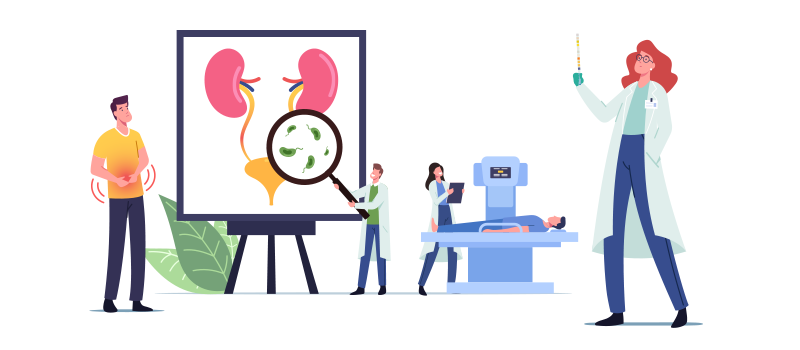What’s the Buzz
The Bee Healthy Blog
The Best Pelvic Inflammatory Disease Treatments

Pelvic inflammatory disease (PID) is an upper genital tract infection of the female reproductive tract. It occurs when bacteria that cause lower genital tract infections, such as gonorrhea and chlamydia, ascend from the vagina into the upper reproductive organs such as the uterus, fallopian tubes, and ovaries. Without treatment, pelvic inflammatory disease can result in serious complications such as chronic pelvic pain, infertility, ectopic pregnancy, and tubo-ovarian abscess formation. Please continue reading to learn about the treatment options for pelvic inflammatory disease.
Who is at risk of pelvic inflammatory disease?
Risk factors to develop PID include:
-
Age younger than 25 years
-
Sexually active women
-
Intrauterine device (IUD) for contraception
-
Unprotected sex without a barrier contraceptive such as a condom
-
Having multiple sexual partners
-
Having a sexual partner who has multiple sexual partners
-
Regular douching
-
A history of sexually transmitted infections or pelvic inflammatory disease
-
Uterine instrumentation (medical procedures that involve insertion of instruments into the uterus)
What are the symptoms of acute pelvic inflammatory disease?
Symptoms of pelvic inflammatory disease include:
-
Lower abdominal pain or pelvic pain that can range in severity from mild to severe
-
Thick vaginal discharge, which may be foul-smelling
-
Bleeding from the vagina during sex or in between menstrual periods
-
Dyspareunia (pain during sex)
-
Pain with urination or frequent urination
-
Fever, chills
Some women may not have any symptoms of acute PID. However, recent randomized clinical trials have shown that even subclinical pelvic inflammatory disease can cause complications such as tubal factor infertility. That’s why it is important to have regular sexual health screenings and seek treatment at the first sign of symptom onset. Early diagnosis and treatment of vaginal and cervical infections can lower your risk of developing PID.
What tests are done for pelvic inflammatory disease evaluation?
Your healthcare provider may order a range of diagnostic tests to make a clinical diagnosis of pelvic inflammatory disease, including a pelvic exam, swab samples from your pelvic organs (cervix and vagina) to be tested for gonorrhea and chlamydia, urine and blood tests for sexually transmitted infections including HIV infection, ultrasound examination, laparoscopy procedure to view your reproductive organs, and an endometrial biopsy to obtain a sample of tissue.
What is the first-line treatment for pelvic inflammatory disease?
The first line treatment for pelvic inflammatory disease is usually parenteral and oral regimens of antibiotics to kill the bacteria that cause sexually transmitted diseases, for example, chlamydial or gonococcal infection. Your doctor will prescribe an antimicrobial regimen that is effective against the specific sexually transmitted organisms identified in your lab results.
Keep all your medical and lab appointments during your treatment for PID. Your provider may ask you to come back for follow-up after 3 days of initiating treatment to evaluate your clinical health. They may adjust the antimicrobial therapy based on your lab results and clinical response.
You should complete the prescribed antimicrobial regimens even if clinical improvement occurs and you start to feel better after a few days of taking antibiotics. Stopping treatment too soon can cause the infection to come back and be more difficult to treat in the future.
Make sure your sexual partner is treated at the same time, even if they don’t have symptoms of a sexually transmitted infection. Expedited partner treatment helps ensure that you don’t get re-infected after a clinical cure of pelvic inflammatory disease.
You will need to temporarily abstain from sexual intercourse until your symptoms are gone, and the infection has cleared.
Most women need only oral therapy for pelvic inflammatory disease. However, alternative regimens, including parenteral regimens (intravenous antibiotics) may be required for treating women who are pregnant, severely ill, or have abscesses.
Surgical intervention is rarely required unless there is a risk of abscess rupture in severe PID, ectopic pregnancy, no response to a parenteral regimen of antibiotics, or the diagnosis of pelvic inflammatory disease is unclear.
What is the latest treatment for pelvic inflammatory disease?
The Centers for Disease Control and Prevention (CDC) has issued the following treatment guidelines for pelvic inflammatory disease. These treatment regimens include parenteral and oral cephalosporins, tetracyclines, nitroimidazoles, and macrolide antibiotics. They provide broad-spectrum coverage against a wide range of bacteria that cause sexually transmitted infections. Some of the outpatient treatment strategies used in clinical practice to cure PID include:
-
A single dose of ceftriaxone 500 mg by intramuscular injection along with oral therapy consisting of doxycycline 100 mg by mouth twice a day for 14 days and metronidazole 500 mg by mouth twice a day for 14 days.
-
A single dose of cefoxitin 2 grams by intramuscular injection with a single dose of probenecid 1 gram by mouth and oral doxycycline 100 mg twice a day for 14 days and oral metronidazole 500 mg twice a day for 14 days.
-
Parenteral therapy with a third-generation cephalosporin such as cefotaxime or ceftizoxime with oral doxycycline 100 mg twice a day for 14 days and metronidazole 500 mg by mouth twice a day for 14 days.
What is the best natural treatment for pelvic pain from PID?
There are no natural treatments that are proven to cure pelvic inflammatory disease. Leaving PID untreated can lead to serious complications. However, you could try the following natural approaches along with the prescribed antibiotic treatment:
-
Eat a healthy diet.
-
Stay well hydrated.
-
Take a multivitamin daily.
-
Take supplements such as omega-3 fatty acids and probiotics.
Do not use herbal remedies for pelvic inflammatory disease without checking with your healthcare provider because some herbs can interfere with prescribed medications.
Some women find alternative and complementary therapies, such as castor oil packs and acupuncture, to benefit chronic pelvic pain.
How to prevent pelvic inflammatory disease?
You can lower your risk of pelvic inflammatory disease by practicing safe sex (using a barrier contraceptive such as a condom every time you have sex). Keep in mind that some forms of contraception, such as birth control pills, do not protect you against sexually transmitted infections.
It is also important to have regular screening tests if you are at risk of sexually transmitted infections. Make sure your sexual partner is also tested and treated if you are diagnosed with a sexually transmitted infection.
Last but not least, avoid douching, as it can upset the natural balance of bacteria in your vagina and increase your risk of pelvic inflammatory disease.
References:












SOCIAL